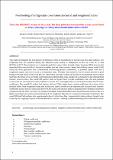Pool boiling of refrigerants over nanostructured and roughened tubes
Author(s)
Bock, Bradley D; Bucci, Matteo; Markides, Christos N; Thome, John R; Meyer, Josua P
DownloadAccepted version (1.545Mb)
Publisher with Creative Commons License
Publisher with Creative Commons License
Creative Commons Attribution
Terms of use
Metadata
Show full item recordAbstract
This study investigated the heat transfer performance of three nanostructured surfaces and two plain surfaces: one roughened and one polished during the saturated pool boiling of refrigerants R-134a at 5 and 25 °C and R-245fa at 20 °C. Nanocoatings were applied to polished copper tubes through a layer-by-layer (LbL) process that deposited silica nanoparticles, a chemical oxidation process where an intertwined mat of sharp copper oxide (CuO) structures were generated and a commercial nanocoating process (nanoFLUX). A polished copper tube and a roughened copper tube were tested as comparison cases. All tubes were tested in the horizontal position in pool boiling over heat fluxes of 20 to 100 kW/m , followed by a further increase in heat flux in an attempt to reach critical heat flux. The tubes were internally water heated and Wilson plots were conducted to characterise the internal heat transfer characteristics. The nanoFLUX surface had the highest heat transfer coefficients, the LbL and polished surfaces had the lowest heat transfer coefficients, and the CuO and roughened surfaces had intermediate heat transfer coefficients. The nanoFLUX surface had between 40 and 200% higher heat transfer coefficients than those of the polished tube. Both roughened tubes and nanocoated tubes showed typical exponentially increased heat transfer coefficients as heat flux was increased. However, the nanoFLUX and CuO surfaces displayed more heat flux sensitivity compared with the other surfaces. The nanoFLUX surfaces outperformed the other nanostructured surfaces due to a higher nucleation site density and outperformed the roughened tube due to a unique heat transfer mechanism. The nanoFLUX and CuO surfaces also experienced reduced critical heat flux compared with plain surfaces, thought to be caused by the trapping of vapour in the fibrous nanostructures, resulting in reduced wetting in the Cassie-Baxter state. 2
Date issued
2020Department
Massachusetts Institute of Technology. Department of Nuclear Science and EngineeringJournal
International Journal of Heat and Mass Transfer
Publisher
Elsevier BV